The Secret Weapon for Opening Padlocks: Shims
The modern pin tumbler cored padlock is a marvel of engineering. It can be pinned in over 3500+ different configurations of pins, driver pins and spools that have to be raised or lowered to exact heights to allow the core to rotate, which causes an actuator located at the end of the key-way to move and in turn, releases the shackle of the lock. Unfortunately many padlocks on the market today can easily be opened with a simple and inexpensive tool, a padlock shim.
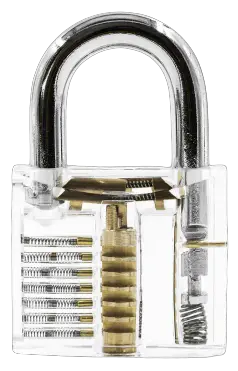
With the addition of master pins, multiple padlocks can be opened by a single “master” key while still having its own unique key which has a completely different bitting to the master key. There is even a special type of core called a builders core that once a specific key is used to open it, all other keys that previously worked the lock will stop working. Impressed yet?
No, well hold my beer cause we are about to learn how a simple flaw in the design of a lot of padlocks can be exploited to completely bypass the precision-engineered core and special security spool pins with…. an empty beer can.
Specifically, what we’re going to be focused on is the spring-loaded lever (sometimes called a locking pawl or a locking bar, depending on which part of the world you’re in) that interacts with this part of the shackle (pictured). When the lock is closed, this lever clicks into the notch in the shackle locking it in place and when the core rotates the locking bar is retracted to allow the shackle to spring open. The design flaw, we can push the spring-loaded lever out of the way and open the padlock with a very simple tool that can be made from very thin metal, like that found in beer or soda cans – this is called a padlock shim.
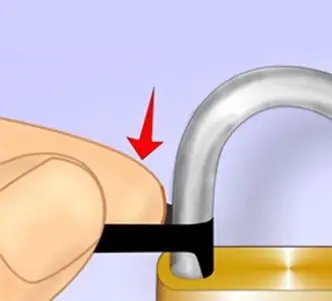
How do padlock shims work exactly?
Padlocks Shim’s are thin pieces of metal that are shaped in such a way that they can enter the top of the padlock where the shackle enters the main body (pictured) of the lock. Once inside the shim is rotated around the shackle, essentially causing the spring-loaded lever or locking pawl to retract away from the notch which holds the lock closed. With the shim pushing the lever out of the way, the lock will open.
How to make a Padlock Shim?

You’ll need a few things to make a padlock shim, a sharp piece of metal or a small pocket knife, a pair of scissors, a permanent marker and of course an empty can. Beer / Soda / Energy Drink can’s are ideal for our purposes.
Taking your sharp piece of metal or pocket knife we going to carefully pierce two holes in the side of the can, as close to the top and bottom as possible and large enough to allow the tip of our scissors into the hole.
Carefully cut all the way around the top and the bottom of the can. There will be sharp edges and you’re very likely to cut to yourself if you rush.
Your final cut should be length-wise down the body of the can (pictured) leaving you with a flat sheet. Depending on the size you want to make your shims, you should be able to get 4 – 6 shims from a single cut and flattened can. Don’t throw away your excess aluminium.

Cutting, Folding & Shaping a Shim.
Below is generally accepted as the most common template to make a padlock shim. There are of course countless variations but I’ve chosen to present this one as it’s worked for me a majority of the time.
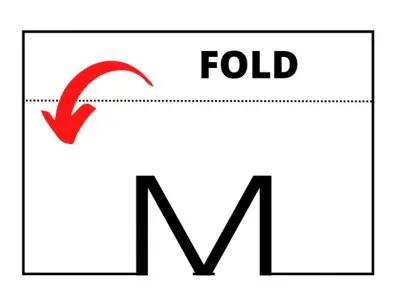
You should aim for making a rectangle of 2 ½ inches x 1½ inches (7-8 cm x 3cm) and your “M” shaped cut out should be approximately 1/3 of the height (½ in) of the shim measured from the bottom edge, as close to the centre as possible.
Next, we want to fold the top one third down towards the M shape cut out. We do this for two different reasons, firstly, we want to cover any sharp edges on the top edge of the rectangle that might come in contact with our fingers during use and second we want to “re-enforce” what we’re going to use as a handle for our shim. Gives it a bit more strength as we insert and turn it.

Once the top is folded down, were going to fold the tabs on either side of our M cut up back towards the top, leaving only the point of the shim exposed. Then there’s just one more step to go before we’re ready to attempt a bypass & I’m going to have to disagree with a certain Lockpicking Lawyer on YouTube about this last step.

In episode 1095 LLP recommends wrapping your newly made shim around a grey lead pencil to shape the shim to a similar curvature as the padlock shackle. I don’t always carry a pencil with me as it’s just easier to take notes on my phone and different lock sizes have different diameter shackles. Since most modern lock manufacturers have been kind enough to include a hardened steel shackle on their locks, I’m going to suggest wrapping your padlock shim around the shackle you are working on to get the right shape.
How to use a Padlock Shim?
Whether you’re using your trusty homemade padlock shim, or you’ve purchased a commercial shim, the process is the same. You’re going to insert the tip of the shim like this (pictured), you’re going to want to work it side to side and apply downward pressure at the same time. Once it’s deep enough, you simply need to rotate the shim towards the center of the padlock body until you feel the shackle spring up.
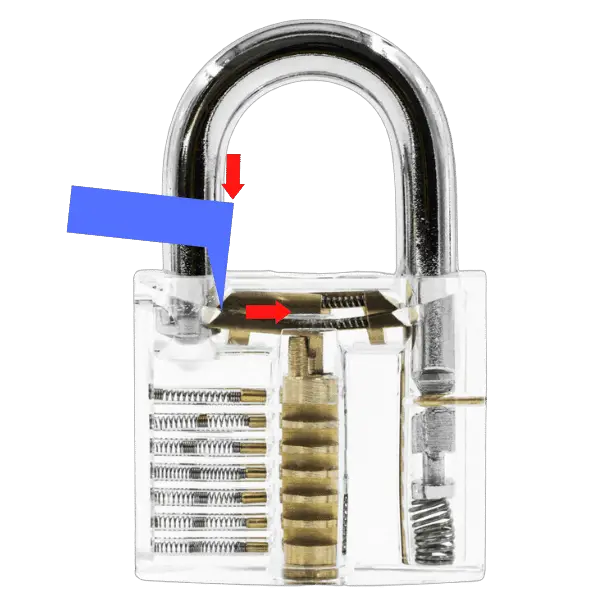
Common reasons why your padlock might not be opening.
- Cheaper Locks have their shackle notch on the non-spring-loaded side of the lock. Are you shimming the correct side of the padlock?
Check on the base of the padlock, you should see a small hole near the key-way. This small hole is to allow for drainage if the lock is used outside, and it tells you which side of the lock the shackle is spring-loaded on… you want to shim the opposite side.
(No hole? Examine the sides of the padlock, you may be able to see 5 tiny indentations, these are the plugs that hold the driver pins and springs in place. You want to shim the same side as the driver pins)
- Your lock may be seized. If you’ve found the lock at a garage sale without a key and you’re not having any luck with your shimming bypass attack, a quick spray of lubricant can often help.
- Re-profile your shim tip. Maybe the pointy end of the shim you insert into the lock body might be just a fraction too long and not enough of the metal is interacting with the spring-loaded mechanism/locking bar to enable it to retract. Using your scissors, round the tip ever so slightly and try again
If you’ve checked you are shimming the correct side of the lock, lubricated the padlock, and re-profiled your shim and it’s still not working….. you may have run across a lock with a double-notched shackle. This little security feature is becoming more and more common and is created by extending the locking pawl at the top of the key-way so that it becomes double-ended, interacting with the notch on each side of the shackle.
Can double-notched locks be shimmed?
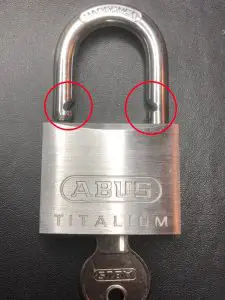
Yes, they can but it’s going to take 2 shims. Remember when I said don’t throw out the leftover sheet of aluminum, this is why. Double-notched padlocks require a shim to be inserted in each side of the lock body where the shackle goes into the lock.
If you have a vice to mount the lock in while you are working on it, you’ll find it not too difficult to insert the shims – in most cases it doesn’t make any difference which side you insert first, the difficulty comes when you’re trying to shim a padlock that’s affixed to something, limiting the angles you can work and the amount of room to get the shims in.
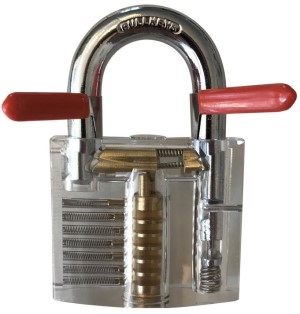
Note: While most padlocks can be shimmed, manufacturers are always upgrading the level of security of their higher end padlocks and over time some of these innovations trickle down to the lower cost offerings. One such security feature involves replacing the spring loaded lever with two independent ball bearings. By using ball bearings instead of a fixed pawl, the notches on the shackles are made to be semi circles that wont allow a shim to access the lock body as seen on this cut away Abus lock (credit – wikipedia : double ball cutaway padlock) or by simply extending the lock body up around the shackle on this German designed Burg Delta series are both effective ways of blocking a padlock shim.
Why have padlock shims in your Lock Pick Kit?
Not all padlocks are created equal and even with a great set of picks like the ones recommended by Lock Judge here and with enough practice you can become proficient in single pin picking or racking your way into a vast number of locks – there’s still a padlock that we haven’t spoken about that is utterly pick resistant…. because it doesn’t rely on keys
Shimming Combination Locks
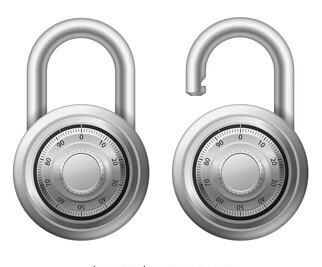
Opening combination locks generally require you to spin a dial a certain number of times to the right stopping on a number, then back around to the left to a second number, and finally back to the right and stopping on the final number. But take a close look at the shackle… Yes, dialing in the correct three-digit combination releases a spring-loaded lever that is susceptible to exactly the same type of bypass attack its keyed brothers and sisters are susceptible to.
Because of the layout of the internals of a combination lock, there isn’t enough room for security features like independent spring-loaded ball bearings so almost every one of them can be shimmed in a matter of seconds.
Newer style combination locks with rotatable discs either on the base or the side allow you to set your own combination without special tools but they do require the padlock to be open and the shackle to be rotated either 90 or 180 degrees and depressed into the lock body before a new combination can be set. This is where having access to a padlock shim can be worth its weight in gold. Especially if the old grey matter has taken a bit of a pounding, emptying beer cans to make padlock shims, remembering what you set your combination will eventually become a problem for all of us.
Conclusion
In conclusion, making your own padlock shims is simple, it’s a reliable way to get open on most keyed padlocks or combination locks for times when you need the lock open to disassemble (to see how it works) or to reset the combination.
As an added bonus homemade shims can be kept unfolded in your wallet or purse, and placed on either side of a credit card as the aluminum will block card skimming attacks for cards equipped with Tap & Go / Paywave. It’s important to remember that Aluminium is very soft and most homemade shims will generally only work once or twice before needing to be replaced. If you are interested in making challenge locks or are working with padlocks that have removable cores where you can set your own key bitting combination then hardened steel Padlock Shim are worth investing in and can be purchased from the following trusted suppliers



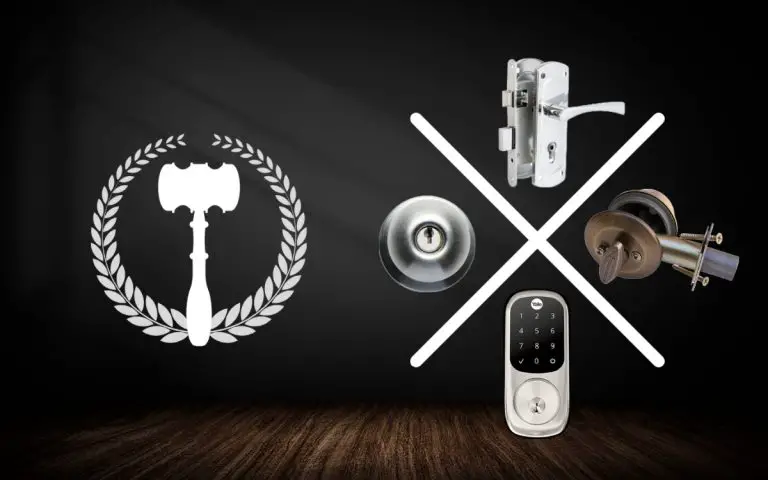
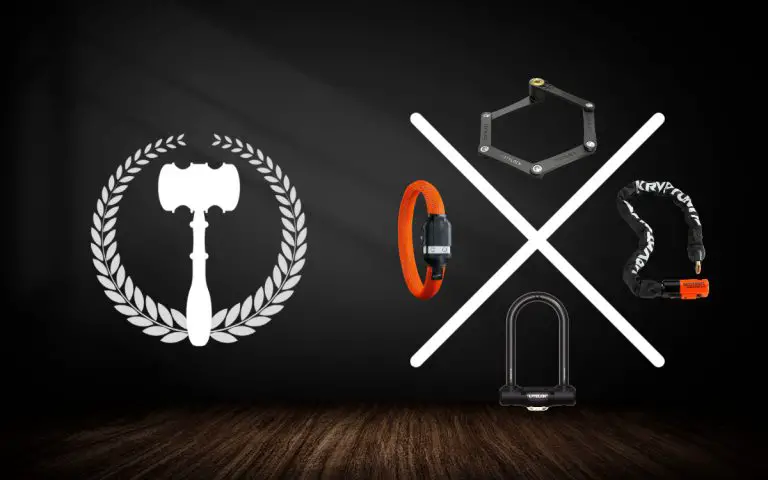
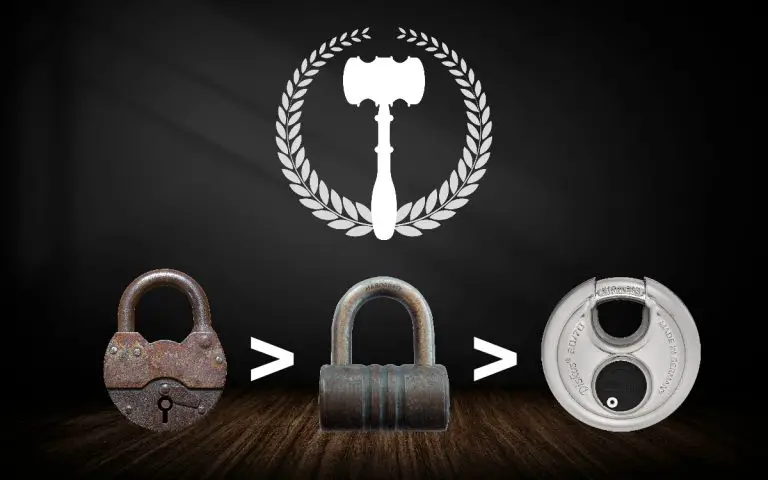



[…] tools, like padlock shims which can be made from empty beer cans, can open combination padlocks sometimes faster than dialing […]
[…] also includes ball bearing locking to avoid shimming attacks and a 6-pin core full of security pins to ensure it won’t be picked […]